Faculty and Staff
Spring RSVP will open Feb. 15, 2026. For more details, visit the Mic/Nite site on the UTK Employee Hub.
Log in for more info
Twice a year, the Office of the Provost hosts Mic/Nite, a “Pecha-Kucha Powered” social gathering designed to enhance the intellectual, interdisciplinary, and cultural life of the faculty and staff at UT Knoxville.
One of the challenges in a large university community is working across the silos that often separate disciplines. Mic/Nite offers an opportunity to build bridges and foster a deeper appreciation of the many facets of a large, comprehensive university. Presentations offer a cross section of the intellectual life of UT Knoxville and provide an opportunity for social interaction among faculty and staff who may not otherwise have the opportunity to interact with each other.
See Fall 2025 presenters and topics
Who Can Attend
UT Mic/Nite is an event for UT faculty and staff (and their guests) and is not open to students or the general public.
Location
Relix Variety Theatre is located at 1208 N Central St, Knoxville, TN 37917. Parking is available behind the venue on Anderson Avenue and on surrounding streets.
Free pizza and a cash bar are available.
What is Pecha-Kucha?
Pecha-Kucha is a simple presentation format that features twenty images displayed for twenty seconds each. The images automatically forward as the presenter talks. To learn more, visit the Pecha-Kucha FAQ. Samples are posted on the Pecha-Kucha Presentations page.
The format originated in Tokyo, Japan. It was first introduced in 2003 and has spread to more than 400 cities around the world. The format allows presenters to depict and describe everything from urban design or economic theory to a series of photographs. Mic/Nite is held in cooperation with PechaKucha Night Knoxville, which was started in 2011 to encourage intellectual and cultural dialogue. Mic/Nites are special interdisciplinary events that facilitate dialogue between university faculty and staff by showcasing the academic pursuits of the campus.
Explore Pecha Kucha events from around the world: PechaKucha 20×20 – Official Site | PechaKucha 20×20 – Knoxville | PechaKucha 20×20 – FAQ
Fall 2025 Presenters and Topics
Assessment, Coaching, and Action
Nancy Scott, PhD, Senior Lecturer, Haslam College of Business

Each year, executives and professionals from a variety of complex industries enter Haslam’s Executive MBA programs for a developmental journey that extends far beyond academics. At the heart of this journey is the Leadership Development Program (LDP), designed to translate evidence-based leadership science into the practice of developing leaders. The LDP unfolds in three phases: 1) a robust suite of assessments that establish a foundation of self-awareness; 2) individualized goal setting and the creation of a personalized leadership development plan; and 3) sustained coaching and practice to refine behaviors and achieve mastery. Students are paired with seasoned executive coaches who provide accountability, perspective, and support as they navigate real-time leadership challenges. Together with the curriculum and Organizational Action Project, the LDP delivers a transformational dimension to the EMBA experience, equipping leaders with the self-insight and intention to lead with impact in today’s dynamic organizational environments.
Descriptive transcript – Scott
Uncharted Territory: An Introvert’s Guide to Social Media
Tena Ursini, DVM, PhD, Assistant Professor, Department of Large Animal Clinical Sciences, College of Veterinary Medicine

Seven, BabySeven, Bambino, Squirt, Punk: no matter what you called the diminutive foal, his impact was immense. His owner’s four million followers on social media posed unique challenges for his medical team at the UT College of Veterinary Medicine. Born two months premature, no one had ever managed the physical rehabilitation of a foal born two months premature; most of them don’t survive. One of UTCVM’s highest-profile cases, Seven’s was exceptionally challenging, fraught with complications, setbacks, and public scrutiny. But his primary veterinarian also recognized the good it could bring to the college. An introvert, she had to navigate not only unknowns in medicine but also a social media world that is foreign to her: juggling weekly video updates, Big Orange Give, initiating an endowed scholarship, recognition in the Atlanta airport, receiving the Professional Bull Riders “Be a Cowboy” award, and instant fandom from people like Betty in Indiana.
Descriptive transcript – Ursini
The Price of Beauty: Lessons from Foot Binding, Corsets, and Their Modern Echoes
Heejin (Jeanie) Lim, PhD, Professor, Department of Retail Hospitality & Tourism Management, College of Education, Health, and Human Sciences
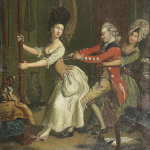 Beauty ideals have shaped—and distorted—women’s bodies and identities for centuries. Though the methods have varied across time and culture, the message has often remained the same: to be chosen, one must conform. This presentation explores the history of these ideals through the lens of foot binding in China and corset use in Europe and considers how their echoes reverberate in today’s cultural and social landscape. Through historic and contemporary case studies and personal reflection, I invite you to reconsider what it means to be shaped—physically and emotionally—by someone else’s standards. This topic has sparked profound insight among students, revealing how deeply many of us remain bound to external ideals that distort self-image and self-worth. What began as a history lesson became something more personal: an invitation to unbind.
Beauty ideals have shaped—and distorted—women’s bodies and identities for centuries. Though the methods have varied across time and culture, the message has often remained the same: to be chosen, one must conform. This presentation explores the history of these ideals through the lens of foot binding in China and corset use in Europe and considers how their echoes reverberate in today’s cultural and social landscape. Through historic and contemporary case studies and personal reflection, I invite you to reconsider what it means to be shaped—physically and emotionally—by someone else’s standards. This topic has sparked profound insight among students, revealing how deeply many of us remain bound to external ideals that distort self-image and self-worth. What began as a history lesson became something more personal: an invitation to unbind.
Society’s Mirror: The Need for Critical Sport Media Analysis
Guy Harrison, PhD, Associate Professor, School of Journalism and Media, College of Communication and Information

From Billie Jean King’s victory in the 1973 Battle of the Sexes tennis match to Colin Kaepernick’s silent protest in 2016, it has been said that sports are a mirror on which society’s social issues—gender, race, politics, and more—are reflected. The bulk of my research has focused on representations of gender and race among those working in sports media, and much of what I have discovered informs, and is informed by, what we know about society writ large. Through a summary of my own research focused on sports media professionals, mixed with a retelling of my own personal experiences, I will illustrate how the sports media industrial complex continues to be a site through which society grapples with issues old and new. This presentation will therefore demonstrate the need for scholars to continue critically analyzing mediated sport.
Descriptive transcript – Harrison
Campus Babies: Motherhood, Home Economics, and the Evolution of Adoption
Megan Birk, PhD, Professor, Department of History, College of Arts & Sciences
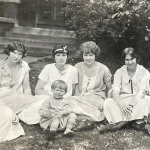
In the 1920s, motherhood in the US was a hot topic. Would working women skip motherhood? How could high child mortality rates be reduced? What should be done with the increasing numbers of children in orphanages? Home economics, the leading degree earned by women, stepped up to provide solutions. Students used science, critical thinking, and practical applications to earn their degree, while also applying these techniques in their own homes as parents, modeling “scientific motherhood” for their communities. Efficiency replaced tradition; science and record keeping replaced sentimentality. But how to teach motherhood? The answer: rent a house near campus, convince a local social welfare agency to lend out a baby, and place students in the house as its primary caretakers. For thirty years, this was a common sight on many land grant campuses (including ours). Children raised by home economics students became highly sought-after adoptees.
Controlled Environment Agriculture: A Tool to Feed Humans on Earth and Beyond
Kellie Walters, PhD, Assistant Professor, Department of Plant Sciences, Herbert College of Agriculture
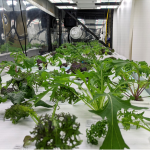
Beyond earth, astronauts currently rely on stored food to provide calories and nutrients. However, some nutrients are deficient in the stored space diet and others degrade over time. Who wants astronauts to get scurvy on the way to Mars?
Access to nutritious food on Earth is also a concern. In 2019, $2.7 billion of lettuce was grown and sold in the United States with nearly all being produced in California and Arizona. With production localized to a relatively small geographic area that is especially susceptible to drought and other environmental effects, the resiliency of our food system is in question.
Controlled Environment Agriculture provides a great opportunity to address these issues by taking the climate variable largely out of the equation. Produce production can be distributed across the country and across the universe by growing tasty, nutrient-dense food terrestrially AND extra-terrestrially.
Descriptive transcript – Walters
Emergency Management: Beyond First Response
Mike Gutierrez, PhD, Teaching Associate Professor, Howard H. Baker Jr. School of Public Policy and Public Affairs
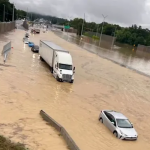
Emergency management is the coordinated process through which communities, organizations, and governments prepare for, respond to, recover from, and mitigate the impacts of hazards and disasters. It is both a practice and a discipline that seeks to reduce vulnerability, protect lives and property, and strengthen resilience against threats ranging from natural hazards to technological accidents and human-caused crises. Guided by principles of collaboration, flexibility, and risk reduction, emergency management emphasizes proactive planning, effective communication, and resource coordination across multiple sectors. Its framework, often summarized by the phases of mitigation, preparedness, response, and recovery, ensures a comprehensive approach that addresses immediate needs while fostering long-term resilience. As disasters grow in frequency and complexity, emergency management plays a critical role in minimizing disruption and supporting sustainable development. Ultimately, it is a collective endeavor that integrates science, policy, and practice to safeguard communities in the face of uncertainty.
Descriptive transcript – Gutierrez
The Hidden and Ubiquitous Power Electronics Technologies Shaping Our Lives
Daniel Costinett, PhD, Professor, Min H. Kao Department of Electrical Engineering and Computer Science, Tickle College of Engineering

From cell phones to the data centers they connect to, electric vehicles to the grid that powers them, electrosurgical generators to the MRIs we avoid getting after image-searching “electrosurgery”, power electronics forms the unseen backbone of modern technologies pervasive in our society. You likely have a dozen power converters in your pocket and hundreds in the car that brought you here. Developments in this field make our devices smaller, last longer, perform better, and cost less while securing our energy future. Driven by advancements in semiconductors and related technologies, emerging applications, and societal needs, the University of Tennessee is powering the continual advancement of our energy future.
Descriptive transcript – Costinett
Dealing with the Fungus Among Us
Todd Reynolds, PhD, Professor, Department of Microbiology, College of Arts and Sciences
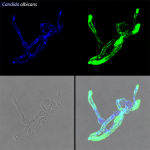
Hundreds of millions of people suffer from fungal infections that afflict the skin, mucosal surfaces (eg. gastrointestinal and vaginal tracts), and deep organs. Of these infections, the most serious are of those of the deep organs (invasive infections), which cause approximately 1.5 million deaths per year. Most patients with invasive infections are immunocompromised, due to conditions like HIV-AIDS, cancer, and/or immunosuppressants. There are three classes of antifungals for invasive infections (azoles, Amphotericin-B, and echinocandins), but their efficacies are limited. These drugs target aspects of the fungal cell envelope, which consists of a plasma membrane and cell wall (humans only have a plasma membrane). Azoles and Amphotericin-B target ergosterol, which differs from human cholesterol enough to make it a good target. Echinocandins target the cell wall, which humans lack, making it an effective drug against some fungi. However, treatment failures still occur, and we will discuss potential reasons and solutions.
Descriptive transcript – Reynolds
Finding Poetry: Responsive Practice, Research, and Relationship
Natalie J. Graham, PhD, Professor and Interim Head, Department of Africana Studies, College of Arts & Sciences
 In this presentation, Dr. Natalie Graham will explore elements of her poetic practice that are rooted in response, research, and formal experimentation. Drawing from her experience as the inaugural Poet Laureate of Orange County, California, she will share a vision of poetry as response to visual art, literature, and history; as a method of inquiry; and as a bridge between personal and collective experience. Dr. Graham will trace her journey from early response poems inspired by Salvador Dalí’s The Temptation of St. Anthony to more recent works that carry readers into and through visual and historical memory in Calida Rawles’ homage to Miami’s Overtown neighborhood, Away with the Tides. Dr. Graham will also share completed poems and poems-in-progress that celebrate the wonderous and often frail mechanics of our bodies and our relationships with one another.
In this presentation, Dr. Natalie Graham will explore elements of her poetic practice that are rooted in response, research, and formal experimentation. Drawing from her experience as the inaugural Poet Laureate of Orange County, California, she will share a vision of poetry as response to visual art, literature, and history; as a method of inquiry; and as a bridge between personal and collective experience. Dr. Graham will trace her journey from early response poems inspired by Salvador Dalí’s The Temptation of St. Anthony to more recent works that carry readers into and through visual and historical memory in Calida Rawles’ homage to Miami’s Overtown neighborhood, Away with the Tides. Dr. Graham will also share completed poems and poems-in-progress that celebrate the wonderous and often frail mechanics of our bodies and our relationships with one another.
Image Credit: Calida Rawles. “Impact”, 2024. Acrylic on canvas. 60 x 72 inches. Photo: Marten Elder
